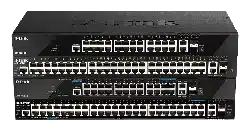Loading ...
Loading ...
Loading ...

DGS-1520 Series Gigabit Ethernet Smart Managed Switch Web UI Reference Guide
98
Parameter Description
Destination Select the destination Switch Unit ID and type of destination file that will be copied
here. Options to choose from are startup-config, running-config, and
Destination File.
Only after selecting the Destination File option can the destination file path and
filename be entered in the space provided. Tick the Replace check box to replace
the current running configuration with the indicated configuration file.
Click the Apply button to initiate the copy.
Click the Cancel button the discard the process.
Stacking
Switches in this series support stacking up to 8 switches together while being managed through one console
connection on the master switch, or by an IP address through the MGMT port if the master is a DGS-1520-28/52, or
by multiple IP addresses through any of the RJ45/SFP+ ports using Telnet, the Web UI, and SNMP. This cost-
effective switch provides an affordable solution for administrators to upgrade their networks using the stacking ports to
scale and stack the Switches. This increases overall reliability, serviceability, and availability.
• Duplex Chain - This topology stacks switches together in a chain-link format. Using this method, data transfer
is only possible in one direction. If there is a break in the chain, data transfer will be affected.
• Duplex Ring - This topology stacks switches in a ring or circle format where data can be transferred in two
directions. It is very resilient due to the fact that, if there is a break in the ring, data can still be transferred
through the stacking cables between switches in the stack using the alternate path.
Switches in the series can be physically stacked with optical fiber cables, standard Ethernet cables, or Direct Attached
Cables (DACs) with SFP+ connectors. Only the last 4 ports on the Switch can be used for physical stacking. Physical
stacking needs to be enabled and can be configured to support a 2-port or 4-port stacking configuration.
When the 2-port 10GBASE-T stacking configuration is used, a full-duplex speed of up to 40Gbps is used between
two switches.
• The DGS-1520-28 uses ports 25 (SIO1) and 26 (SIO2) for 2-port stacking.
• The DGS-1520-28MP uses ports 25 (SIO1) and 26 (SIO2) for 2-port stacking.
• The DGS-1520-52 uses ports 49 (SIO1) and 50 (SIO2) for 2-port stacking.
• The DGS-1520-52MP uses use physical ports 49 (SIO1) and 50 (SIO2) for 2-port stacking.
When the 2-port SFP+ stacking configuration is used, a full-duplex speed of up to 40Gbps is used between two
switches.
• The DGS-1520-28 uses ports 27 (SIO1) and 28 (SIO2) for 2-port stacking.
• The DGS-1520-28MP uses ports 27 (SIO1) and 28 (SIO2) for 2-port stacking.
• The DGS-1520-52 uses ports 51 (SIO1) and 52 (SIO2) for 2-port stacking.
• The DGS-1520-52MP uses ports 51 (SIO1) and 52 (SIO2) for 2-port stacking.
When the 4-port stacking configuration is used, a full-duplex speed of up to 80Gbps is used between two switches
using four physical ports aggregated into two virtual stacking ports.
• The DGS-1520-28 uses ports 25 (SIO1), 26 (SIO2), 27 (SIO1), and 28 (SIO2) for 4-port stacking.
• The DGS-1520-28MP uses ports 25 (SIO1), 26 (SIO2), 27 (SIO1), and 28 (SIO2) for 4-port stacking.
• The DGS-1520-52 uses ports 49 (SIO1), 50 (SIO2), 51 (SIO1), and 52 (SIO2) for 4-port stacking.
• The DGS-1520-52MP uses ports 49 (SIO1), 50 (SIO2), 51 (SIO1), and 52 (SIO2) for 4-port stacking.
Loading ...
Loading ...
Loading ...
